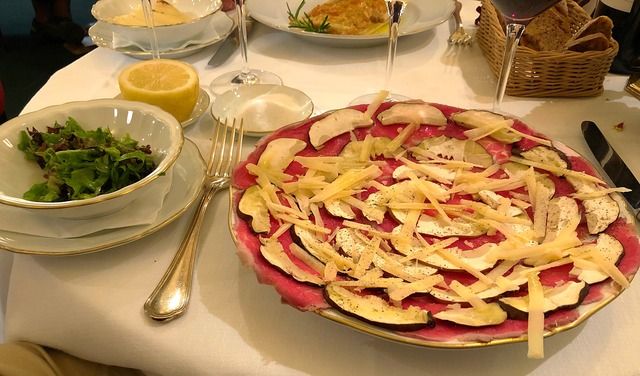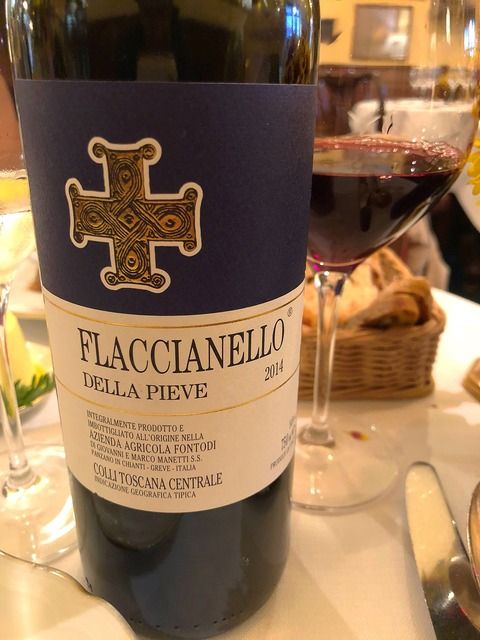On a recent trip to Tuscany, for Sunday, the 3rd June 2018, 11am, I had booked Catha & myself for a "Historical Vintages" tasting (i.e., old vintages of their Chianti Classico Riservas, private tour included, by pre-booked appointment only) at Badia a Coltibuono in Gaiole, Chianti. We were based in Montalcino at the time, so we had to get up a little earlier for the approximately 1&1/2 hours' winding drive northward. We made it in good time.
Originally built in the 11th century to be a monastery of the Vallombrosan Order of Benedictine monks, it was eventually bought in 1846 by wealthy Florentine banker Michele Giuntini. Passed down through the years to his descendants, now the Stucchi-Prinetti family (for lack of male Giuntini heirs at some point), one of whom, a lady, still lives there (but travels very often). I understand that she has a son; but he doesn't live there.
 |
| The estate's French styled gardens. |
 |
| The old well from which the monks drew their water. |
Restored 16th century paintings and furniture line the corridors. These are still in actual use - one can sit in the chairs. In other venues, these would be just for display, cordoned off from use.
Down to the cellars where their wines are aged in varying sizes of oak barrels. The vineyards and modern winery themselves are 15 minutes' drive away; but the finished wines are brought to this estate for ageing.
In this part of the cellar are kept the estate's old vintages. It is from here that the bottles for the "historical vintages" tasting are taken. The very oldest bottles, of course, are not made available for tastings; but are kept by the family for historical purposes.
On the music lounge's ceiling is an old restored mural of the Vallombrosan order's symbol. The old abbey's original oratory was dedicated to San Lorenzo di Coltibuono who was martyred by being roasted alive over a grill - hence the grill with a crown. The hand on the right side holds a stick used for farming purposes, identified with the Vallombrosan order's founder, San Giovanni Gualberto.
 |
| Old restored mural of San Giovanni Gualberto. |
The tour done, we settled outside for the tasting.
It wasn't one of those ubiquitous tastings during which one gets small pours of each wine. Four bottles of their Chianti Classico Riserva were open in our presence; and the bottles were ours to do as we wished. The older vintages that day were 1994, 1970 & 1969, with a current 2013 thrown in for comparative purposes.
The 1994's cork stuck stubbornly to the sides and would crumble in the middle when pulled; thus, necessitating straining into a decanter. Uncorking the 1970, 1969 and, of course, the 2013, presented no such problems.
The 1994 was the heftiest amongst the older wines, being a few notches over medium-bodied. It also came off as the most concentrated. I figured it would be the best for a meal. The 1970 was in notably good shape for a 48 year-old wine, presenting serene, contemplative soft fruit. The 1969 was comparatively the least in body, concentration, heft and ripeness, as we detected some greenness/stemminess, as well as drying tannins in the finish.
None of the older ones had particularly long finishes. Over-all, it appeared to me that the producer goes for a more old-school, classic, drier, acid balance lifted, elegant style as opposed to the richer, riper, lower acid modern style.
After the tasting session, Catha & I chatted with our guide (a very charming German lady who is married to an Italian) until a little before 2pm, then walked to the producer's nearby on-site restaurant for lunch; bringing along the rest of the older bottles (we left the remains of the 2013). Immediately above depicted is Catha's pasta course with squid, tomatoes, black olives and toasted breadcrumbs.
My pasta course featured braised duck sauce.
As we were to have dinner not too long from then, Catha didn't want a main course. Mine was the Braised Rabbit Leg en Fricassee. With it, I had mainly the 1994, and, thereafter, some of the 1970. The 1969 I poured a bit of to see if it would improve. It didn't. After a double espresso each, we drove back to Montalcino.
In all, the tasting and tour were quite enjoyable. The wines themselves were nice enough in varying degrees (well, except the 1969). I certainly wouldn't mind having their 1970 again; and am curious about their 1985, mid to late '90s and their 2001. We shall see.

















